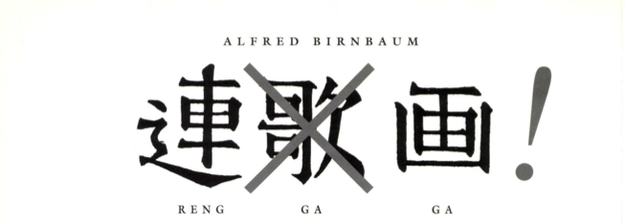In practice, the participants at a renga session would take turns composing short verses of 5-7-5 syllables alternating with 7-7 syllables. Each verse had to play upon the verse immediately preceding in such a way that any two adjacent segments formed one coherent poetical idea, although three consecutive segments did not necessarily work together. These hybrid poems often ran to one-hundred links, all of which were written on sheets of decorative paper that were folded and bound into booklets, many of which survive to this day. Also extant are a number of aesthetic treatises on the art, most notably the Sasamegoto or ‘Whisperings’ of Shinkei (1406- 1475), which extensively list precise rules for types of links - direct, oblique and associative - as well as for which subjects were to figure at what point in the overall composition - seasonal words in the final link of each quarter of the poem, here a reference to the moon, etc. The starting verse or hokku was considered the most crucial as it set the tone for the whole poem to follow, and so the honour of launching the session fell to the most experienced poet. Very hierarchical, very Japanese.
Over time, successive practitioners added so many rules that the art collapsed under the weight of its own complexity. But not before engendering yet newer art forms such as the world-famous haiku, which evolved from the hokku . The hybrid aesthetics of renga likewise underwrite much of Japanese sensibilities even today. The electronic epistolary ‘video letter’, long the mainstay of the JVC Tokyo Video Festival and arguably the most popular Japanese video art, probably owes a great deal to the renga.
One last footnote to our pictorial cadavres : the idea of renga might easily be transposed from the verbal to the visual by a rather unconventional combination of kanji characters, substituting ‘picture’ for ga ‘verse’ to render a new hybrid genre. Anyone for Renga ‘Round the Globe> 100 thirty-second video links, say, of alternating 5-7-5 and 7-7 cuts, sent around the world on one videocassette? The dreams of technology breed logistical nightmares. Dozo, osaki ni... ‘Please, you first...’
Voor meer informatie over renga, lees/For further reading on renga, see: Earl Miner Japanese Linked Poetry. Princeton University Press 1979 & Hiroaki Sato One Hundred Frogs: Weatherhill Tokyo, 198
Mediamatic Magazine vol 4 # 1+2 1 Jan 1989
Reng Ga Ga
Footnote to a Cadavre
The cadavre exquis finds an interesting parallel in the ancient Japanese poetical genre of renga or ‘linked verse’. An exactingly disciplined aesthetic exercise that was the height of aristocratic fashion in 15th-16th century Kyoto, renga gatherings brought together four to six poets - typically Buddhist priests and courtiers - simple rooms for long hours of escape from ‘worldly matters’. There would be a view of a garden, a scroll painting of Hitomaru, the patron saint of Japanese poetry, would hang in the tokonoma alcove, and saké or tea would be served. Herein lie the origins of chanoyu, the Japanese ‘art of tea’.
